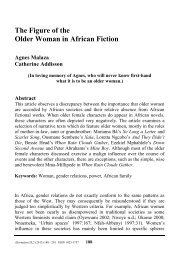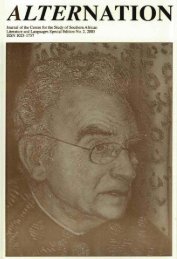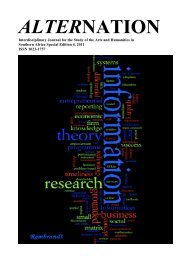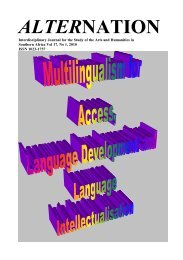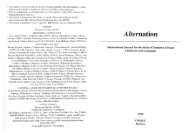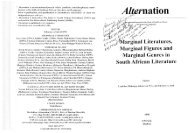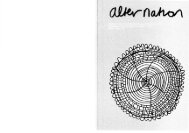Re-reading The Purloined Letter - Alternation Journal
Re-reading The Purloined Letter - Alternation Journal
Re-reading The Purloined Letter - Alternation Journal
You also want an ePaper? Increase the reach of your titles
YUMPU automatically turns print PDFs into web optimized ePapers that Google loves.
Pravina Pillay<br />
anything but ‘faithful’ and ‘true’. She is also, as Queen, in a social position<br />
or role that is, clearly symbolic—in the ‘merely symbolic’ sense of the<br />
term—since she exercises, obviously, no ultimate power. She fears the King,<br />
and as such is literally subject to him, to his power. Flower and Cannell<br />
(1986:32) write:<br />
Son seigneur et maitre—her Lord and Master. Not light words for<br />
Lacan, who analyzed the discourse of mastery as one of the four<br />
discourses, the four forms of the social tie. <strong>The</strong> Queen is really<br />
subject neither to the signifier as such nor to the neutral code (the<br />
way things are) but to the specific institution of marriage in which<br />
her husband is her ‘Lord and Master’.<br />
As such, she has to play the game of the signifier, and bow down to it<br />
because the Queen is subject to the moral order, an order in which a very<br />
concrete other—the King—has all the prestige, power and authority to make<br />
her keep her place. According to Flower and Cannell (1986:32), like<br />
Johnson, we all easily overlook the social tie. Possibly Lacan wanted to<br />
demonstrate how willing we are to overlook it, to keep it offstage in our<br />
involvement with the signifier. But Lacan also wanted us to remember how<br />
disconnected we are.<br />
Lacan concludes his seminar on <strong>The</strong> <strong>Purloined</strong> <strong>Letter</strong> with the<br />
remark that ‘a letter always arrive at its destination’. This lends credence to<br />
Lacan’s belief that the letter operates as a signifier whose signified is<br />
irrelevant and it can have and lose its place only in the Symbolic Order. I<br />
will discuss this in detail when evaluating Žižek’s defense of Lacan.<br />
3 Derrida’s Critique of Lacan’s <strong>Re</strong>ading of <strong>The</strong> <strong>Purloined</strong><br />
<strong>Letter</strong><br />
However accomplished his writing, Derrida’s criticism of Lacan has a<br />
predictable ring. Schneiderman (1991:154) states that to refute Lacan,<br />
Derrida falls back on the points Lacan has always been criticized for: the<br />
failure to give sufficient weight to the imaginary, to the ego, to narcissism, to<br />
the horrors of corporeal fragmentation. In a sense one may rightly say that<br />
Lacan could have given more weight to these areas, though one should in the<br />
386



